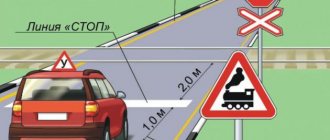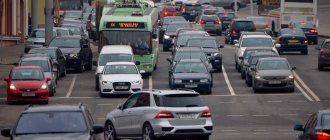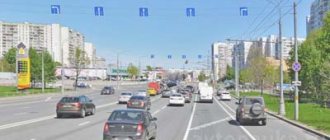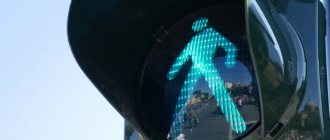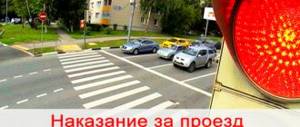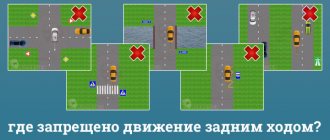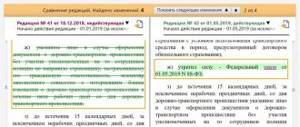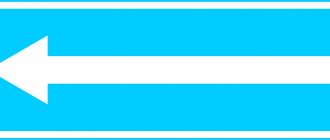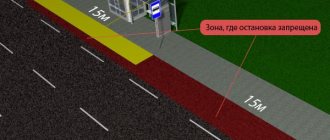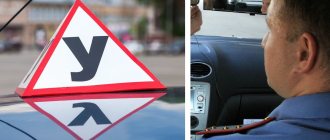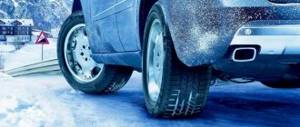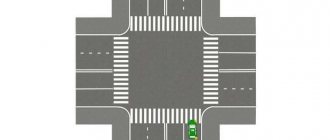Despite the fact that all drivers can make a U-turn, it can be difficult to do it correctly at various types of intersections without violating traffic rules, since many nuances need to be taken into account. Performing this maneuver requires the driver not only to be attentive, but also to know which type of transport has priority on those parts of the road that are or are not regulated by traffic lights.
All features must be taken into account not so much for passing the exam in order to obtain a driving license, but for daily driving, so as not to provoke emergency situations and accidents, deprivation of rights and the issuance of a fine.
What traffic rules say about the 2021 U-turn rules
In the set of traffic rules, paragraph No. 8 is devoted to a description of the correct turn. General rules for drivers to prevent accidents:
- Before performing such a maneuver, you need to give a signal using a light indicator on the side in which the car is turning. If this is not possible, you need to give a signal with your hand, bending it at the elbow at a right angle.
- The signal cannot be given at the moment of the turn: it must be done in advance, and completed immediately after it is completed.
- When turning left or right, the driver needs to take the extreme position on the road. This does not apply only to those cases when you need to turn when entering an intersection.
Rules for turning at intersections - The turn must be carried out so that the car does not end up on the side of oncoming traffic.
- If there is a braking lane, then you only need to reduce speed before the maneuver.
- According to traffic regulations, you cannot turn in places of increased danger: pedestrian crossings, tunnels, bridges, stops, railway crossings, places with limited or poor visibility of the roadway.
- If the vehicle cannot turn according to the rules due to its size or other reasons, deviation from the rules is allowed. However, this should not cause any interference or danger to other vehicles.
Common Questions
- Why is it more convenient to make U-turns at an intersection? Turning is considered one of the most dangerous movements, so experienced drivers try not to take risks by choosing the best option for this purpose - a controlled section with cross traffic. In this case, the permitting signal eliminates the risk of collision with cars from adjacent roads, and all the driver has to do is let those who are approaching him or turning right pass.
- In what cases is a U-turn prohibited? You cannot turn around not only at the crossed out road sign 3.19, but also under signs indicating pedestrian crossings (5.19.1/5.19.2), a tunnel (1.31), a railway, regardless of the number of tracks (1.3.1/1.3.2), dangerous or several dangerous turns (1.11.1/1.11.2), steep ascent and descent (1.13/1.14), stopping public transport (5.16/5.17), as well as movement in a certain direction (4.1.1/4.1.2/4.1 .4). Among other things, changing the direction of traffic to the opposite direction is not allowed in areas with one or two continuous median strips.
Also, do not confuse the signs, remembering that a prohibited turn to the left does not imply a refusal to maneuver in the oncoming direction and, on the contrary, a change in the movement vector in this case will be welcomed, unless it interferes with other traffic participants.
How to correctly make a U-turn at an intersection during the exam
In order to successfully pass the license exam, it is enough to take into account several nuances and follow the learned rules. The main ones regarding turns:
- When turning right/left, you must first take an extreme position on the road, which is intended for movement in that direction. This does not apply to an intersection with a roundabout.
- When turning right, the vehicle should be as close as possible to the right edge of the road.
- If you are making a left turn, you can sometimes move into the lane needed for oncoming traffic, although this is prohibited by the rules in most cases.
- Most often, turning rules are violated in the winter season. The main reason is the road surface hidden under the snow and the formation of ruts.
It should be taken into account that the width of the road is not limited by the knurled section. We must not forget to take the extreme position to perform the maneuver. - You cannot make a U-turn at a zebra crossing: even running into this part of the road can lead to failure of the exam.
- You cannot turn around outside an intersection if there is no visibility of 100 meters or more.
- Be sure to turn on the required direction indicators when performing maneuvers.
U-turn technique at a T-junction
There are two types of such intersections. In the first option, the adjacent road is located on the right, in the second - on the left. In any case, virtually any vehicle can turn around on such a section of the road. If you are the owner of a huge jeep with a large turning radius, it is better to find a safer place to turn, because you should not perform a maneuver in several steps here.
So, the driver’s main task is to make a U-turn in one go and maintain the integrity of the bumpers and body of his car. To do this, you need to complete the following tasks:
- approach the intersection and reduce your speed to a safe speed for turning around;
- choose a convenient place to perform the maneuver;
- if the road is adjacent to the right, enter this road and perform a circular maneuver in one step;
- if the road is adjacent to the left, you need to press as close as possible to the right side of the road and then perform a maneuver to enter the adjacent part.
Video:
No traffic police officer has the right to punish you for such a U-turn if there were no signs in front of the intersection restricting this action. Purely for reasons of preserving your budget, it is not recommended to perform U-turns in areas that are questionable for this maneuver in unfamiliar cities. The sign could be hidden behind the city's flora; you could miss it while trying to find a place to turn around.
Schemes and rules for making a U-turn at various intersections
The rules for turning around depend on the type of intersection at which the maneuver is being made. At the same time, some types of transport have advantages in traffic, which also need to be taken into account when making turns.
Regulated
At an intersection that is regulated by a traffic light, this maneuver is easiest to perform, since the driver only needs to let the oncoming traffic pass. Traffic on the right and left will be stopped by a traffic light. The driver is required to:
- compliance with the direction of movement according to the markings;
- making sure that there is no sign in front of the intersection that prohibits the maneuver.
Turning at a signalized intersection
Equivalent
An equivalent intersection has three main features: it is not regulated, there are no priority signs, and the surface on the intersecting roads is the same. To turn around correctly in such a place, the driver needs to know who is “in charge”:
- a tram has an advantage over a car, regardless of where it is going;
- Drivers of trackless vehicles are required to give way to vehicles moving on the right;
- if there is no vehicle on the right, you can start moving.
Turning at an equivalent intersection
T-shaped
Almost any passenger vehicle can turn around at this type of intersection. An exception may be large vehicles whose turning radius is too large. To perform this action, you need to find the safest place: here you cannot drive in reverse (fine - 500 rubles) and perform a series of turns. General rules for safe driving:
- you must follow the “Main Road”, “Stop” and “Give Way” signs;
- if there are no signs at the intersection, the main rule for drivers is “Interference on the right”;
- When driving, turning on the direction indicators is mandatory;
- when the road is narrow, movement along the far path is required, along the near path - if the road is wide.
Turning at a T-junction
With tram tracks
In accordance with traffic regulations, rail transport has an advantage over other types. The first one gives way to passenger vehicles only if he himself is driving on an adjacent road, and the car is driving on the main road.
Remember! If there is a traffic light at the intersection that regulates the movement of trams and cars, the first will be a priority.
When the light for the car is green and the light for the tram is red, the latter is stationary. However, he can start moving towards the arrow that was turned on along with the red traffic light sign - and this is a violation.
If there is no traffic light at the intersection, then the tram will also have priority.
With dividing strip
On roads with this type of marking, there are 2 ways to turn: when the lane reaches or crosses an intersection:
- The first case requires performing a maneuver only along a small trajectory, since there is usually enough space on such roads. Entering the intersection of roads is strictly prohibited and is punishable by a fine.
- In the second case, the rules allow turning only on a large radius, otherwise the vehicle will continue to move in the oncoming lane for some time, which is also not allowed.
Turning on a road with a median
But you need to consider:
- when making a maneuver, you need to take into account how wide the dividing strip is;
- if it is spacious, and the driver turns around a small radius, he faces deprivation of his license;
- when the line is narrow (about 20 cm), there will be no penalty, since oncoming traffic is not intense.
Fines for violating U-turn rules
Neglecting the rules for turning around at road intersections is punishable by fines, the amount of which directly depends on what exactly the motorist forgot or did incorrectly.
For example, maneuvering without a turn signal is fraught with a penalty of 500 Russian rubles. The same tariff applies when turning from any lane other than the left one, as well as in a prohibited zone.
Reversing at road intersections is also prohibited, which most often happens when the driver cannot correctly calculate the trajectory of his movement, choosing a small arc for maneuvering.
In this case, he will also have to pay 500 rubles for his inexperience.
If you change the direction of movement in areas with prohibitory signs or markings, the fine will automatically increase by 2 or 3 times, amounting to 1000-1500 rubles. But the most unacceptable mistake is driving in oncoming traffic, and this pleasure will cost the hooligan 5 thousand or a six-month deprivation of his license.
Why you can lose your license if you make an incorrect turn
A driver is not always deprived of his license if he violates the rules of turning around at an intersection. In some cases, the penalty may also be a fine:
- If you choose the wrong trajectory and make a U-turn at the border of the intersection, you may end up in the oncoming lane. For the first violation of traffic rules, the minimum fine - the most lenient punishment - will be 5,000 rubles. When a repeated violation is recorded, deprivation of rights for 4-6 months is possible. One more trip into the oncoming lane will result in deprivation of your driving license for 1 year.
- The driver is not deprived of his license if, due to an incorrect maneuver, the car drove beyond the boundaries of the intersection of 2 roads.
Only a fine of 1,500 rubles is possible. - A fine of 500 rubles is issued when a vehicle is reversing or making a multi-stage turn at a T-junction. Since such actions greatly increase the risk of an emergency, another similar violation may result in deprivation of the right to drive.
- Your license can also be taken away for making a small-radius turn at an intersection where there is a dividing line. The period for which the right to drive is not available is 4-6 months.
Such a violation is considered serious by law, and the punishment for it is appropriate, since the car ends up in the oncoming lane.
Rules and techniques for performing a U-turn according to traffic regulations
Only the technology of turning at an intersection is considered, assuming that all other norms have already been fulfilled by the driver according to the rules: the lane has been changed into the required lane, the turn signal has been turned on, vehicles with priority have been allowed to pass, etc.
The main rule for turning around at an intersection is that the car should not enter the lane of oncoming traffic, and the actual trajectory of movement should fit into the area where the roadways intersect .
Optimal turning trajectory
This can be a large or small radius, if the conditions of the intersection, markings, vehicle dimensions, etc. make it possible to maneuver within the intersection of roadways. However, at intersections with a median or with prohibitory markings extended into the intersection, a short-radius turn may not be possible.
Rice. 2. Permissible turn on a small and large radius
Rice. 3. U-turn at an intersection with a median
Rice. 4. Violation: did not fit within the limits of the intersection of roadways - hitting the curb.
Rice. 5. Violation: collision with a pedestrian crossing.
Rice. 6. Violation: driving into oncoming traffic.
Is it possible to turn around if there is a “No left turn” sign?
Drivers are often confused, considering a ban on a turn to be equivalent to a ban on a U-turn. It is not always so. Sign 3.18.2 does not allow a left turn, but does not prohibit a U-turn .
Rice. 7. Scheme of turning around at an intersection
Is a small radius turn allowed?
We have already touched on this issue superficially. Let's look at it in a little more detail. There are no rules directly prohibiting this maneuver, which does not prevent conflicts between the traffic police and drivers from arising from time to time.
If a turn is not prohibited by markings or signs, then a short-radius maneuver is possible and should not be a violation. However, it is precisely a small-radius turn that often causes the traffic trajectory to not fit into the framework of the intersection zone of carriageway lanes, which means it will force the vehicle to enter the lane of oncoming traffic.
8(800)350-23-68
Dmitry Konstantinovich
Expert of the site "Legal Consultant"
Ask a Question
In this case, while not being a violation in itself, a small radius turn can lead to other traffic violations, incl. implying serious fines and deprivation of the right to drive a vehicle.
It will not be a violation to make a small-radius turn if a special place is allocated for it, and the maneuver does not lead to driving into oncoming traffic.
In case of controversial situations, issued decisions must be appealed. To do this, they resort to the help of auto lawyers. We will tell you how to consult with a lawyer for free at the end of this article.
